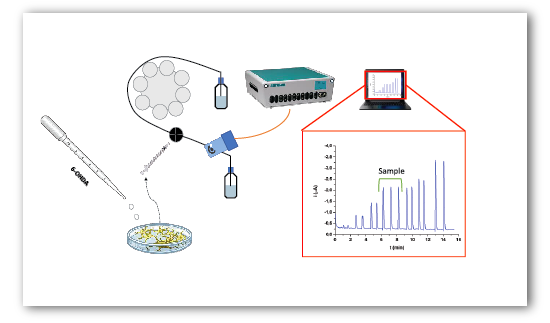NANOSTRUCTURED SCREEN-PRINTED ELECTRODES FOR HYDROGEN PEROXIDE SENSING IN CELL CULTURES
CATANIA, from 21 to 23 of February 2018.

Daniel Rojas
Flavio Della Pelle
Michele Del Carlo
Dario Compagnone
DEPARTMENT
Faculty of Bioscience and Technology for Food, Agriculture and Environment
UNITE
- ABOUT
-
Reactive Oxygen Species (ROS) are reduced forms of oxygen such as superoxide anion (O2 ·- ), hydroxyl radical (OH· ) or hydrogen peroxide (H2O2). These molecules have a critical role in physiological processes like cellular signalling and immunological activity. However, an overproduction may cause the so-called oxidative stress (OS) which is able to cause damage to lipids, proteins or DNA . These alterations promotes pathophysiological conditions such as diabetes, cancer, Alzheimer’s and Parkinson’s disease . Hydrogen peroxide was selected as molecular marker of OS since it is the most stable ROS and its final metabolite. ScreenPrinted Electrodes (SPE) are disposable and cost-effective devices; the small volume required for measurements allows in-situ electrochemical measurements of cell cultures medium. In addition, the possible nanostructuring of surfaces improves selectivity and sensitivity. These features, makes the nanostructured SPE very appealing for the measurements of OS markers directly in cell cultures and biological media ,. An appropriate nanostructured surface modification allows the interference-free detection and an improvement on the analytical signal, this is especially important when the levels of ROS are very low (1-10 nM in physiological conditions and >100 nM in pathophysiological conditions). Prussian Blue (PB) is one of the most know electrocatalyst for H2O2 reduction. PB allows low potential and interference-free detection of H2O2 in oxygenated ambient, nonetheless has some disadvantages such as poor stability at physiological pH and high crystallization rate which hinders the potential nanostructuring and application in biological media . To overcome these shortcomings the electrode modification with soft or hard templates, polymers, carbonaceous materials or different metals are used in different combinations for build specific analytical platforms for each application. In this work Carbon Black (CB) has been successfully used as electrode modifier, PB was then electrosynthetized on the modified SPE’s surfaces improving hydrogen peroxide sensing. The SPE modified electrodes were coupled to a Flow Injection Analysis (FIA) system and applied to measure the OS levels in cells challenged with 6-hydroxidopamine (6-OHDA) as an experimental model of Parkinson’s disease.
- CNS
-
The “Covegno Nazionale Sensori” (CNS) is a biannual interdisciplinary meeting organized by the most important scientific societies in Italy. The 4 th CNS 2018 will take place in Catania from 21 to 23 of February 2018.
The CNS 2018 presents an important opportunity to get the feel of the state of sensors research and to present the results of the most relevant results of ESR2 at the very beginning of the research project. The meeting is a strategic place to create new collaborations for developing new sensing strategies and further collaborations that could be very useful in the project’s course.
Rep-Eat
H2020-MSCA-COFUND-2015
University of Teramo - Via Renato Balzarini 1
64100 - Teramo (TE) - Italy

REP_EAT MSCA Co-funding of regional, national and international programmes (COFUND) HORIZON 2020” – Grant Agreement N. 713714.CUP: C47B16000360007

 NANOSTRUCTURED SCREEN-PRINTED ELECTRODES FOR HYDROGEN PEROXIDE SENSING IN CELL CULTURES
NANOSTRUCTURED SCREEN-PRINTED ELECTRODES FOR HYDROGEN PEROXIDE SENSING IN CELL CULTURES

